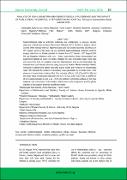| dc.contributor.author | Babangida, Bala Garba | |
| dc.contributor.author | Nazziwa, Aisha | |
| dc.contributor.author | Noor, Kasim | |
| dc.contributor.author | Adiukwu, Roseline Nwawure | |
| dc.contributor.author | Ngaloru, Stellamaris Ngozi | |
| dc.contributor.author | Mafuyai, Yaks Mabur | |
| dc.contributor.author | Obi, Edith Nkeiru | |
| dc.contributor.author | Onwunali, Magnus Chibueze | |
| dc.contributor.author | Obanny, Adolphus | |
| dc.date.accessioned | 2017-03-24T13:17:37Z | |
| dc.date.available | 2017-03-24T13:17:37Z | |
| dc.date.issued | 2016 | |
| dc.identifier.citation | Babangida, B.G ... et al (2016) Analysis of non-linear transmission of EBOLA virus disease and the impact of public health control interventions in hospital: the case of Guinea (West Africa) outbreak 2014. Islamic University Journal, Vol.5(1) P.10-29 | en_US |
| dc.identifier.issn | 2409-0263 | |
| dc.identifier.uri | http://hdl.handle.net/20.500.12309/57 | |
| dc.description.abstract | ARTICLE ABSTRACT
Epidemiological data on infection outbreaks are challenging to analyze, despite improved control interventions Ebola virus Disease (EVD) remains a serious risk in Guinea (West Africa) with 607 reported cases and 406 deaths recorded (66.8%) as of 20th August, 2014.In this study we use modified epidemiological modeling SEIR to analyze data from an Ebola outbreak in Guinea from 22nd march – 20th August,2014 We use Bayesian inference with non – linear transmission times incorporated into augmented data set as latent variables. Despite the lack of detailed data, most data sets record the time on symptom onset but transmission time is not observable. We inferred from such dataset records using structured Hidden Markov Models HMMS. Infectivity is determined before and after public health interventions for hospitalized cases. We estimate the number of secondary cases generated by an index case in the absence of control interventions (Ro). Our estimate of Ro is 1.57 (CI95 0.82-1.92) and the mean value of estimated detection rate is 0.75 (CI95 0.59 -0.93) with a coefficient of correlation between 𝛽𝛽 and v as – 0.23. We perform sensitivity analysis of the final epidemic size to the time of intervention, which ensures the uniqueness and the global stability of the positive endemic equilibrium state. | en_US |
| dc.language.iso | en_US | en_US |
| dc.subject | Epidemiological | en_US |
| dc.subject | Ebola | en_US |
| dc.subject | Disease | en_US |
| dc.subject | Markov models | en_US |
| dc.title | Analysis of non-linear transmission of EBOLA virus disease and the impact of public health control interventions in hospital: the case of Guinea (West Africa) outbreak 2014. | en_US |
| dc.type | Article | en_US |

